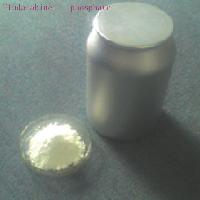-
Categories
-
Pharmaceutical Intermediates
-
Active Pharmaceutical Ingredients
-
Food Additives
- Industrial Coatings
- Agrochemicals
- Dyes and Pigments
- Surfactant
- Flavors and Fragrances
- Chemical Reagents
- Catalyst and Auxiliary
- Natural Products
- Inorganic Chemistry
-
Organic Chemistry
-
Biochemical Engineering
- Analytical Chemistry
-
Cosmetic Ingredient
- Water Treatment Chemical
-
Pharmaceutical Intermediates
Promotion
ECHEMI Mall
Wholesale
Weekly Price
Exhibition
News
-
Trade Service
preface
Brain metastases have long been the "nightmare" of patients with anaplastic lymphoma kinase (ALK)-positive non-small cell lung cancer (NSCLC
The emergence of buquatinib, a brain protector, broke this deadlock and gave ALK-positive NSCLC brain metastase patients hope of
Expert Profiles
Professor Su Chunxia
Deputy Director of the Department of Oncology, Shanghai Pulmonary Hospital, Tongji University
Deputy Director of the Department of Internal Medicine, Shanghai Pulmonary Hospital affiliated to Tongji University
Chief physician, professor, doctoral supervisor
Youth Member of oncology Branch of Chinese Medical Association
Secretary of the WCLC at the World Congress on Lung Cancer 2022
Vice Chairman of CSCO Patient Education Committee of Chinese Society of Clinical Oncology
Deputy Secretary-General of CSCO Translation Committee of Chinese Society of Clinical Oncology
Standing Committee Member of CSCO Immunotherapy Committee of Chinese Society of Clinical Oncology
Vice Chairman of the Youth Council of Shanghai Anti-Cancer Association
Secretary-General of TheMatic Committee on Molecular Targeting and Immunotherapy for Lung Cancer of Shanghai Anti-Cancer Association
Author of the "Guidelines for the Clinical Application of CSCO Immune Checkpoint Inhibitors"
Author of the Guidelines for the Administration of Toxicity Associated with CSCO Immune Checkpoint Inhibitors
Author of Shanghai "Resident Common Malignant Tumor Screening and Prevention Recommendation"
Medical Pulse: ALK-positive advanced NSCLC treatment is gradually moving towards "precision" and "long survival", what unmet needs do you think exist in the current clinical practice?
Professor Su Chunxia
Shanghai Pulmonary Hospital affiliated to Tongji University
ALK is often referred to as the "golden target"
In clinical practice, the incidence of brain metastases in patients with initial ALK-positive NSCLC is high, and the risk of intracranial progression continues to accumulate with the course of the disease2,3, while patients with brain metastases usually have a poor prognosis, relatively short survival, and seriously affected
In addition, although targeted drugs can significantly prolong the survival time of patients, the problem of drug resistance is inevitable
At present, there is still no relatively unified consensus
As a second-generation ALK inhibitor, bugotinib has achieved a staggering 75% reduction in the risk of disease progression and death in patients with baseline brain metastases, and a 4-year OS rate of 71% in patients with brain metastases.
Professor Su Chunxia
Shanghai Pulmonary Hospital affiliated to Tongji UniversityExperts in the field of lung cancer are familiar with bougatinib, but it can be described as "late" in China's clinical practice
The ALTA-1L study explored the efficacy and safety of bugotinib in ALK-positive NSCLC patients who had not previously been treated with an ALK inhibitor, and the newly published findings also answered the question of brain metastases
.
For patients with baseline brain metastases, bugotinib achieved impressive results in reducing the risk of disease progression – as assessed by the BIRC (Blind Independent Review Committee), the PFS was up to 24 months and the HR value reached 0.
25, which means that the risk of disease progression and death of patients is reduced by 75%, which fully reflects the good benefit trend
of first-line use of buguetinib in patients with brain metastases.
In addition, among patients with baseline brain metastases, the intracranial lesion response rate of bugotinib reached 78%, while the control group of zotinib was only 26%, an increase of 3 times! Meanwhile, in patients with baseline brain metastases, the median sustained response time of bogetinib can be as long as 27.
9 months (9.
2 months
in the control group).
These clinical study data fully demonstrate the therapeutic advantages of bogetinib in patients with brain metastases
.
In addition, for patients with baseline brain metastases, the 4-year OS rate of buguetinib assessed by BIRC can reach 71%, which shows the maturity of their data and the advantages of buguetinib in brain transfer control5
.
Figure 1: Main study endpoints of the ALTA-1L study
In the intentional therapy (ITT) population of the ALTA-1L study, intracranial PFS of bubutinib was as high as 44.
1 months6
.
This is not only a surprising result, but also fully demonstrates that bugotinib has a long-lasting brain protection effect in both patients with concomitant brain metastases and potential high-risk groups of brain metastases
.
The research data of buguetinib has enabled clinicians to gain strong confidence in medication, and it is expected that in future clinical practice, more patients will benefit from buguetinib, so that brain metastases will no longer become a clinical treatment problem
.
Most of the improvement in patients' quality of life is due to the relief of intracranial symptoms, and bugotinib can achieve the dual benefits of survival and quality of life, what do you think this means for clinical patients?
Professor Su Chunxia
Shanghai Pulmonary Hospital affiliated to Tongji UniversityAt present, several second-generation ALK inhibitors have been applied to the clinic, clinicians should pay attention to the control of brain metastases while paying attention to the systemic efficacy of the drug, and clinicians should choose drugs with better efficacy to develop treatment plans to provide patients with more lasting benefits
.
As the survival time of ALK-positive NSCLC patients increased, clinicians began to advocate the concept
of "live long, live well".
In the ALTA-1L study, buguetinib was able to significantly delay the deterioration of health/quality of life (GHS/QoL)5 compared with the control group,5 and toned the dual benefits
of buguetinib in survival time and quality of life.
Figure 2.
ALTA-1L study GHS/QoL deterioration data
In addition, clinicians should not only pay attention to the efficacy of the drug before formulating the drug regimen, but also the adverse reactions should not be ignored
.
In the ALTA-1L study, the trial group introduced 90 mg of buguetinib in the first week and increased the dose to the standard dose of 180 mg at the second week to continue treatment5,7
.
The clever dose-in-time design allows bugotinib to demonstrate good overall safety in subsequent studies
.
Bugotinib improves patient benefits without significantly impairing the quality of life of patients, achieving a "win-win"
.
Based on the results of boogetinib in randomized controlled versus real-world studies, I am confident
in the clinical practice of boogatinib.
Medical Pulse: The driver gene positive NSCLC, including ALK positive, has gradually entered the "chronic disease" stage
.
As a member of the Non-Small Cell Lung Cancer Committee of the Chinese Society of Clinical Oncology, you have been committed to the whole process of lung cancer patient management
.
So, how do you define "full management"? What are the key links? What insights do you have on how to better manage patients with positive driver gene mutations throughout the process?
Professor Su Chunxia
Shanghai Pulmonary Hospital affiliated to Tongji UniversityPatients with a positive driver gene should have a more comprehensive molecular diagnosis
prior to treatment.
When the patient has systemic progression, the clinician should encourage the patient to re-biopsy, analyze the mechanism of drug resistance, and guide the direction of subsequent precision treatment according to different resistance mechanisms
.
If the patient is unable to re-biopsy, the mechanism of resistance can be determined by liquid biopsy
.
It is worth noting that there are differences between clinical practice and translational studies, and whether the resistance mechanism results obtained after re-biopsy are enough to change the treatment strategy still needs to be fully communicated
with the patient.
As mentioned above, although ALK inhibitors have achieved three generations of the same house and provided patients with a wealth of drug choices, how to give the most reasonable treatment decisions is still an important "topic" in the whole process of management, which needs to be further explored and learned by
clinicians.
In addition to the efficacy of the drug, the mechanism of drug resistance is clear, and the reasonable "platoon deployment", clinicians should also pay attention to the adverse reactions produced by patients during medication, improve the quality of life of patients under the reasonable "platoon deployment", and improve patient medication compliance and tolerance
.
Therefore, clinicians should give drugs that take into account both efficacy and toxicity in first-line treatment, so that patients can ensure the quality of life and enhance confidence
in follow-up treatment while gaining long-term survival.
In today's rapid update and iteration of science and technology and therapeutic drugs, the treatment of lung cancer has gradually moved towards the process of chronic disease, showing a stable and good trend, and it is also expected that the full line of approved bugotinib can bring more surprises to lung cancer patients!
References:
[1] Fallet V, Cadranel J, Doubre H, et al.
Prospective screening for ALK: clinical features and outcome according to ALK status[J].
European journal of cancer, 2014, 50(7): 1239-1246.
[2] LI Caihe,HU Changchen,CHENG Dongdong,WANG Xiaoyu,GUO Jianzhong.
Progress in targeted therapy for brain metastases in non-small cell lung cancer[J].
China Hospital Drug Evaluation and Analysis,2022,22(04):497-503.
[3] Rangachari D, Yamaguchi N, VanderLaan P A, et al.
Brain metastases in patients with EGFR-mutated or ALK-rearranged non-small-cell lung cancers[J].
Lung cancer, 2015, 88(1): 108-111.
Wang Chen,Chen Shuzhen.
Research progress on the mechanism of acquired resistance of EGFR-TKIs in the treatment of non-small cell lung cancer[J].
Acta Pharmaceutica Sinica,2019,54(08):1364-1371.
[5] Tiseo M, Popat S, Kim H R, et al.
29P Brigatinib (BRG) vs crizotinib (CRZ) in anaplastic lymphoma kinase (ALK) tyrosine kinase inhibitor-naive ALK+ non-small cell lung cancer (NSCLC): ALTA-1L final results[J].
Annals of Oncology, 2022, 33: S44-S45.
[6] Camidge D R, Kim H R, Ahn M J, et al.
Brigatinib versus crizotinib in ALK inhibitor–naive advanced ALK-positive NSCLC: final results of phase 3 ALTA-1L trial[J].
Journal of Thoracic Oncology, 2021, 16(12): 2091-2108.
[7] Camidge D R, Kim H R, Ahn M J, et al.
Association of depth of target lesion response to brigatinib with outcomes in patients with ALK inhibitor-naive ALK+ NSCLC in ALTA-1L[J].
2022.
Disclaimer: For use by healthcare professionals only for informational purposes
.
Such information should not in any way replace professional medical guidance and should not be considered a medical advice
.
If such information is used for purposes other than information, this site and the author do not assume relevant responsibility
.
Approval code: C-APROM/CN/ALUN/0252
Date of approval: August 2022
Reviewer: Fish balls
Typography: moly
Execution: Uni
END






